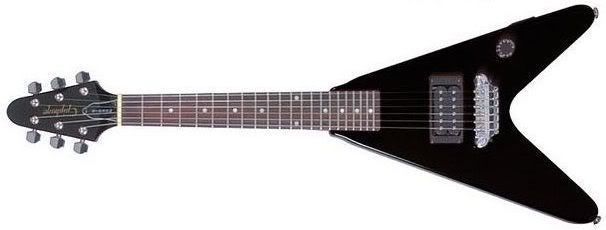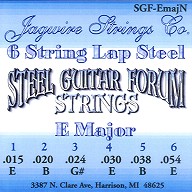It's the Flying Vee Wee. Adjust the action and maybe swap the pup, but other than that, what do ya think? It sounds like a good plan. :idea:
A couple of questions -
It's tuned - G C F A# D G
Is that open G? If not, what is it?
Will the scaling make a large difference in the tone?
I would plan on throwing 14's on it. The short neck should hold. Do you think the bridge will?
Thank you,
Mike
-Edited picture
That tuning sounds like if I put a capo on a regular guitar tuned in standard.
Wait, let me think....yah, it's like barring straight across at the 3rd fret, so it's...G Standard I guess you'd say.
Open G would be DGDGBD. Dobro G is GBDGBD
There's bunch of other G tunings, but those are the 2 that I've tried.
Cool mini guitar by the way. I like that little amp too!
I'm presuming it's tuned that way because of the shorter scale - you play an E chord shape on that....
G C F A# D G
0 2 2 1 0 0
and what will sound is a G chord. If the manufacturer - or savvy guitarists - recommend the G C F A# D G tuning, then the closest you're going to get to open G is F Bb F Bb D F - that's open Bb, with the same intervals between strings as open G tuning. Note the root is on the 5th string, and note also that you've got the Bb major triiad - Bb D and F on strings 2 3 and 4 (though not in that order!) and also on the top 3 strings. To play a G chord open in that tuning you'd have to use a full barre across the ninth fret.
To get a G chord playing all six strings open, you'd need an open E style tuning.....so tune the 5th string down 2 steps, the fourth down 2 steps, and the 3rd down 1 step.....you've now got G D G B D G, and the root note iis now on the bottom string instead of the fifth, and the major triad, G(I) B(III) D(V) is now on strings 4 3 & 2.
The normal open G tuning....D G D G B D - would involve a lot of retuning from your G C F A# D G tuning....
:D :D :D
Vic
"Sometimes the beauty of music can help us all find strength to deal with all the curves life can throw us." (D. Hodge.)
Thanks for the info guys! 8) Good stuff Vic, thanks!
I think I got it. Same as capo on the third fret.
I should mention it's for lap style. Sorry if you guys knew that already but hey, I'm new in these here parts. :D
I think it would work out. Is there anything anyone can think of that might help me?
I plan of inspecting everything first and see what it needs, if anything. I'm thinking it might need a pup change, but you never know. Maybe sand it, slap a clear coat on. Don't know on that one yet. I would probably want to put a 1" - 1-1/2" lift with rubber feet, one under the head stock and one under each wing tip.
I'm still thinking about getting it. It's small, I can hide it. :roll:
You will need to raise the nut for lap steel playing, an extension nut from Elderly would probably do the job.
The ad doesn't say what scale length it is, but I would guess somewhere around 21-22" and in that case a .014 set would almost be too light - I use 015-056 for open-D, E, and highbass-G on a 25" lap steel (but I don't need to worry about the neck of course...).
Steinar
I'm presuming it's tuned that way because of the shorter scale - you play an E chord shape on that....
G C F A# D G
0 2 2 1 0 0
and what will sound is a G chord. If the manufacturer - or savvy guitarists - recommend the G C F A# D G tuning, then the closest you're going to get to open G is F Bb F Bb D F - that's open Bb, with the same intervals between strings as open G tuning. Note the root is on the 5th string, and note also that you've got the Bb major triiad - Bb D and F on strings 2 3 and 4 (though not in that order!) and also on the top 3 strings. To play a G chord open in that tuning you'd have to use a full barre across the ninth fret.
To get a G chord playing all six strings open, you'd need an open E style tuning.....so tune the 5th string down 2 steps, the fourth down 2 steps, and the 3rd down 1 step.....you've now got G D G B D G, and the root note iis now on the bottom string instead of the fifth, and the major triad, G(I) B(III) D(V) is now on strings 4 3 & 2.
The normal open G tuning....D G D G B D - would involve a lot of retuning from your G C F A# D G tuning....
:D :D :D
Vic
Wow, what an excellent, complete answer! Dude, you REALLY have been studying a lot!
And another good point, which I think Steinar also got into, is with a shorter scale-length, regular strings would be way too loose. Thicker strings, or as was mentioned, that open E, or, a version of the open G, but with everything up 3 halfsteps:
F Bb F Bb D F
But that's open Bb, and kinda weird as far as 'regular' songs are concerned. Better to just get a thicker gauge set and try the other ideas.
Again Vic - dude, you're on it!
Ah, thank you Steinar! I thought I was missing something.
Just found a review of someone who did the same thing I am thinking about doing and they said this about the tunings -
For slide, these are the standard open tunings you can use with this guitar: C = GCGCEG, D = ADADF#A, G = GDGBGD, A = AEAC#AE. Drop the major 3rd tone a half step to get the minor tunings. Note: This short-scale guitar will not allow the 6th string to be tuned to E.
Another person said the pup was pretty good too.
I didn't notice it was discontinued from MF until I looked for the scaling info. I messed around with one today while I was at GC and thought is was really cool. I'll have to go back tomorrow and see if they still have one. I'm really not interested in the amp though.
I gotta get it! :shock: My Craftsman deep sockets keep calling my name, make them stop!!! AHHHHHHHHHHHHHHHHH!!!!!!!
We posted near the same time Demo.
The person that converted his to a lap steel said he uses 13's. I planned on 14's and Steinar recommended 15's possibly.
Are there different strings for lap steels or are we talking about normal guitar strings here?
Which size should I start out on? Split the difference and start with the 14's?
Thanks for all the help so far. You guys run a tight ship around here! :D
You can go about this in two ways,- either use regular medium strings and tune to a higher pitch or use fatter strings and go for a 'normal' lap steel tuning. The tunings in the review that you quoted, are voiced differently than one would normally do with lap steel tunings.
It would help a lot to know the scale length of this guitar, but a majority of lap steels are only 22,5" and I doubt it's very much shorter than that (the shortest lap steel I know of are the cheap Artisans that's also sold by GC, they're only 21" if memory serves me right).
Both sustain and tone will suffer if the scale is too short, so you should keep this in mind. There are some very good deals on decent vintage lap steels on eBay, as an alternative option..
Anyway, these are the strings I use mostly for open-E and high-G, they can be ordered from the Steel Guitar Forum:
Asher Guitars offer some heavier sets - .015, .018, .028, .038, .048, .058 - I often use those for my Asher in open-D.
A .058 should work fine for a low E, even on a very short scale instrument.
Steinar
Cool, lap steel strings! Thank you for the links too. :D
I was thinking (that's scary), if the scale is a little on the short side, I could always move the bridge back a little.
Maybe fill in the old holes with some lead. I know it wouldn't make too much of a difference, but it's a step in the right direction I guess. Maybe even bore the holes out a little more for more lead.
What's the best way to measure a short scale? From the inside of the nut to the 12th and then double that? or will inside of nut to inside of saddle do?
I appreciate the help everyone, thank you. 8)
I could always move the bridge back a little.
Uh oh.... If you do that then the frets will no longer be accurate. Even if you plan to play it as lap steel you really need those frets.
You can measure the scale length like you said,- either nut-12th fret and double that, or nut-bridge.
Steinar
Ahhh, ok. See, me and thinking don't always get along. :lol:
Thank you, I leaving now to go check one out.
I got it for the heck of it. Who knows, little here little there and it might turn into something.
The measurement came out to 19" (nut to bridge) which I would think is too short but, I'll EQ it and see where that takes me. Maybe slap a lap neck on it later if it doesn't work out.
Well, I have a little bit of upgrading to do. The saddles aren't adjustable, so a new bridge is in order. I'll need the nut extender, a new set of strings and a few 1" pegs for feet.
So, what do you think now knowing the scale length?
the shortest lap steel I know of are the cheap Artisans that's also sold by GC, they're only 21" if memory serves me right.Your memory's still serving you right, Steinar. My Artisan's a 21" scale.
"A cheerful heart is good medicine."




